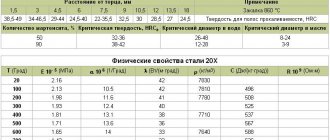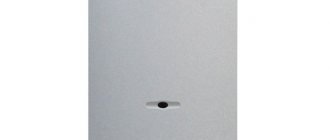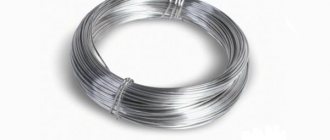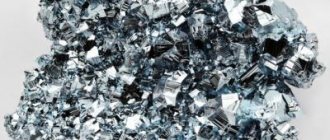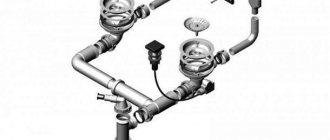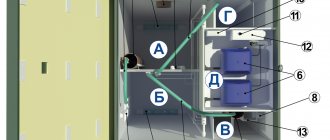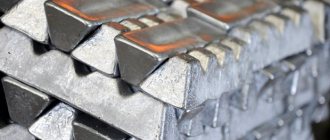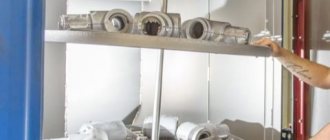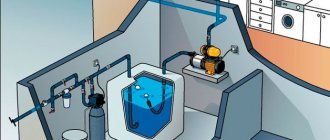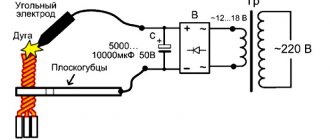general description
Cast iron alloys, like steel alloys, consist of iron and carbon. The function of carbon, in this case, is to give the metal hardness and strength. But unlike steel, which contains no more than 2% carbon, cast iron alloys are more saturated with it. The maximum carbon content in cast iron can reach 6%. But in practice, compounds containing 3%-3.5% of this substance are used.
Thanks to carbon saturation, this alloy acquires high strength and hardness. But these same qualities make cast iron brittle. Cast iron products cannot withstand shock loads. They crack when hit. Therefore, this metal is not amenable to any type of processing except casting. All products, including machine parts, dishes and interior items, are cast.
APPENDIX 3 (recommended)
APPENDIX 3 Recommended
Table 1
Indicators of tensile strength of heat-resistant cast irons at elevated temperatures (short-term tests)
| Cast iron grade | Tensile strength, MPa, at temperature, K | ||||
| 773 | 873 | 973 | 1073 | 1173 | |
| CHH1 | 196 | 147 | 68 | 29 | — |
| CHH2 | 196 | 147 | 78 | 29 | — |
| CHH3 | 167 | 147 | 88 | 29 | — |
| CHH16 | 440 | 294 | 137 | 88 | — |
| CHH32 | 392 | 294 | 196 | 98 | 68 |
| ChS5 | 118 | 98 | 49 | 19 | — |
| ChS5SH | 440 | 382 | 118 | 39 | — |
| CHYUHSH | 343 | 235 | 130 | 78 | — |
| CHY7H2 | 294 | 226 | 157 | 29 | — |
| ChYu6S5 | 118 | 98 | 49 | 19 | — |
| CHYU22SH | 245 | 275 | 168 | 137 | 78 |
table 2
Mechanical properties (short-term tests) and modulus of normal elasticity of nodular graphite cast irons at 873 K
| Cast iron grade | Tensile strength, MPa | Tensile yield strength, MPa | Relative extension, % | Impact strength, dJ/cm | Modulus of normal elasticity, MPa |
| no less | |||||
| ChN19H3Sh | 250 | 180 | 2,0 | 2,0 | 11·10 |
| CHN11G7SH | 300 | 180 | 10 | 2,0 | 12·10 |
| CHYU22SH | 350 | — | 0,5 | 0,5 | 13·10 |
Table 3
Long-term strength and creep rate of nodular cast irons at high temperature
| Cast iron grade | Long-term strength at 873 K | Creep rate, %/h, at a stress of 40 MPa | |
| Tension, MPa | Time to destruction, h | ||
| ChN19H3Sh | 120 | 1000 | 1.0 10 (873 K) 2.0 10 (973 K)* |
| CHN11G7SH | 120 | 1000 | 1.8 10 (873 K) |
| CHYU22SH | 100 | 1000 | 4.0 10 (973 K)* |
_______________ * Creep rate at a temperature of 973 K and a stress of 30 MPa.
Types of alloys
Carbon in cast iron can be contained in two forms:
- in the form of cementite - a chemical compound;
- in the form of graphite - a natural mineral that is an analogue of carbon.
Cementite gives the alloy a white color, and graphite gives it a gray color. Due to this feature, two types of cast iron are distinguished - white and gray. Gray cast iron contains large graphite inclusions, which significantly increase its brittleness.
The use of the white variety is very limited. Due to its excessive hardness and brittleness, it is difficult to cut. Therefore, it is most often used to create a surface layer that requires increased hardness. Balls are also cast from a white cast iron compound and are intended for grinding industrial raw materials.
Graphite adds plasticity to the material. But the gray variety contains more harmful impurities in the form of sulfur and phosphorus, which cannot be eliminated during the production process.
In order to increase the ductility of cast iron and reduce its brittleness, magnesium and cerium are added to the alloys. With the help of these substances it is possible to change the shape of graphite and, accordingly, eliminate the fragility of the metal. As a result, manufacturers receive high-strength cast iron, the quality of which is not inferior to steel.
Also, modern production methods make it possible to obtain malleable and alloyed cast iron. The name of the first modification does not indicate the possibility of metal processing by forging. It only indicates the high strength, ductility and toughness of the alloy.
4. CONTROL METHODS
4.1. (Deleted, Amendment No. 1).
4.2. Samples to determine the chemical composition of cast iron are taken according to GOST 7565.
When smelting cast iron in a cupola furnace, samples to determine the chemical composition are taken in the middle of the melt under conditions of a steady-state continuous process. Samples are marked with the heat number. The chemical composition is determined on one sample.
It is allowed to determine the chemical composition on a casting or workpiece for mechanical testing.
4.3. Chemical analysis of cast iron is carried out according to GOST 28473, GOST 2604.1 - GOST 2604.11, GOST 2604.13. For similar cast iron castings of the same grade, the use of physical methods for determining the composition is allowed.
4.4. Tensile testing of graphite-containing cast iron is carried out on one of the samples in accordance with GOST 27208.
Tensile testing of nodular cast iron is carried out on one cylindrical sample with a diameter of 10 mm and a calculated length of 50 mm according to GOST 1497.
Samples for determining tensile strength are cut from separately cast bars, the shape and dimensions of which are shown in Figures 1 and 2, as well as from special bosses for the casting or directly from the castings. The dimensions and location of bosses in the mold in relation to the casting, as well as the location of cutting samples, are established in the technical documentation for specific castings.
Damn.1
_______________ * Selected as a multiple of the length and number of samples.
Damn.2
It is allowed, by agreement between the manufacturer and the consumer, to control the strength of similar cast iron castings of the same brand using non-destructive methods.
4.5. The bending test is carried out on separately cast samples with a diameter of 30 mm and a length of 300 mm in accordance with GOST 27208.
4.6. When manufacturing cylindrical hollow castings, it is allowed to test the hoop strength modulus on one sample in accordance with GOST 9583 or GOST 621. The dimensions of the samples to determine the hoop strength modulus are established by agreement between the manufacturer and the consumer.
4.7. Determination of Brinell hardness is carried out according to GOST 27208 and GOST 9012 on castings or samples for mechanical testing. The hardness of wear-resistant castings must be determined according to Rockwell, Vickers, and also Brinell - with a tungsten carbide ball.
By agreement between the manufacturer and the consumer, it is allowed to determine the hardness of similar castings of the same grade of cast iron by physical methods.
4.8. (Deleted, Amendment No. 1).
4.9. Selection and preparation of samples, assessment of the shape of graphite inclusions in cast iron castings with nodular graphite are carried out at a magnification of 100 according to GOST 3443.
4.10. The growth resistance of cast iron is determined on three samples with a length of 100-150 mm and a diameter of 20-25 mm by the change in length (in percent) over 150 hours of testing at a given temperature.
4.10.1. Determination of scale formation is carried out according to GOST 6130.
In graphite-containing grades of cast iron, it is necessary to take into account the reduction in mass due to decarburization. It is allowed to increase the height of cylindrical samples K10 and K15 up to 50 mm.
Section 5 (Deleted, Amendment No. 1).
Features of the production of malleable cast iron
The production of KCh cast iron has a number of subtleties that are determined by casting characteristics and other properties.
Ductile iron production
Cast iron of the BC grade, which is the main product of malleable iron, does not have very good casting parameters. In particular, it has reduced fluidity, a large amount of shrinkage during cooling, and it is prone to the formation of various casting defects. These are the reasons why during production it is necessary to overheat the metal and take measures to combat casting defects. The production of malleable cast iron can be carried out with the obligatory consideration of shrinkage and changes in the dimensions of the workpieces during simmering. Thin workpieces have maximum shrinkage, thick ones have minimal shrinkage. The simmering operation is performed at 1350 - 1450 degrees Celsius.
Annealing (simmering) is a basic step in the production of cast iron. It is produced in separate workshops called languid. The preparations are placed in pots made of steel or cast iron alloys of different grades for simmering. Up to 300 castings can be placed in a pot, based on the fact that up to 1,500 kg should be per cubic meter.
Malleable cast iron gains its greatest strength in pots made from white cast iron with chromium additions and a minimum amount of phosphorus. The consumption of pots is measured by weight; it can range from 4 to 15% of the weight of the workpieces. That is why increasing their durability plays a big role in determining the cost of finished malleable cast iron.
To avoid warping of the finished castings, placing the blanks in pots must be done with special care. They are laid as tightly as possible; to enhance the effect, the workpieces are sprinkled with sand or ore. These materials protect the workpieces from deformation and excess oxidation.
Electric furnaces are used to produce malleable cast iron. This is due to the fact that during the simmering process it must be possible to regulate the temperature, a sharp rise during heating and a rapid decrease at the stage of its graphitization. In addition, it will not be superfluous to be able to adjust the air mixture in the oven.
Most of the furnaces used to produce malleable cast iron are muffle furnaces. That is, the products of fuel combustion do not come into contact with the pots in which the workpieces are placed.
Castings made from malleable iron go through a cleaning operation several times, and after annealing, feeders are removed and straightened. The first cleaning is carried out to remove residual molding sands. For cleaning, sandblasting equipment or special tumbling drums are used. Removal of feeder residues occurs using emery cloth.
Read also: Natural and synthetic rubber in brief
Malleable cast iron defects
The most common defects in malleable cast iron are the following:
- shrinkage cavities;
- underfilling;
- cracks, etc.
Some defects cannot be corrected by further heat treatment. It should be noted that the production of malleable cast iron requires strict compliance with all GOST requirements, technological rules and regulations. Only in this case can we talk about obtaining high-quality malleable cast iron, which can be used to replace other, expensive materials - steel, non-ferrous metals.
Advantages and disadvantages of the material
It is worth discussing in comparison with steel, although low-quality carbon steel is essentially the same as cast iron.
In some parameters (density, magnetic properties, typical chemical reactions) ferroalloys are almost identical. There are significant differences in the technology of use.
Advantages:
- Moderate cost.
Carbonation is part of the smelting process from ore. A decrease in its content will inevitably increase the price of the metal.
- Excellent casting qualities.
The melt is fluid. With low crystallization shrinkage, which minimizes defects. Relatively low melting point.
- The products are durable, have a hard surface, and are wear-resistant.
- The compositions used in mechanical engineering can be processed by cutting.
- Durable.
Including plumbing and sewer parts.
- Items that have become unnecessary are easy to recycle. Any reception point with hands will be torn off.
Flaws:
- Due to the high carbon content it is fragile. Not very suitable for pressure treatment. Certain brands produce forged products of excellent quality. But this is rather piece work and unprofitable on an industrial scale.
- Welding is allowed only in extreme cases. The technology is quite complex, and the risk of defects is high.
- The products are always massive. A thin-walled structure will not work, since it will not support its own weight and will not be able to be manufactured.
- Easily oxidizes in a humid environment. It will not rust through due to its inevitable monumentality, but it will take on an unkempt appearance. Parts located outdoors require a corrosion-resistant coating.
How is the marking of cast iron designated and deciphered?
Example of short designations for cast iron
One of the main advantages of cast iron is its widespread use as a casting alloy. Due to the characteristics of the material, almost anything can be made from it. Currently, these products are made everywhere, from automobile construction to serious military developments, for example, in tank building.
During the use of this material, metallurgical production came to the point that it modified the composition and made several of its varieties. This allows you to use the advantages of a particular brand in advance for specific tasks. In general, the following types and subtypes of cast iron are known today. We will look at them along with the markings.
Types of malleable cast iron
The grade of cast iron alloy KCh is directly related to the conditions under which annealing is carried out. After this operation, three classes of cast iron are obtained:
The first contains in its chemical composition ferrite and carbon of a flocculent structure. The second includes pearlite and graphite with a flocculent structure. The third contains ferrite, pearlite and flake-like carbon.
Types of malleable cast iron
Malleable pearlitic cast iron results from rapid cooling of the workpiece while it is in the decomposition zone. In this case, in addition to ferrite, the structure of cast iron will contain pearlite. It will persist even with further cooling of the workpiece to a temperature lower than 727 degrees.
That is, we can say that the structure of cast iron is strictly related to the annealing temperature conditions and the presence of alloying components.
Cast irons with special properties.
Depending on the purpose, wear-resistant, anti-friction, heat-resistant and corrosion-resistant cast irons are distinguished.
Wear-resistant (anti-friction) cast iron.
Designated by a combination of the letters AChS, AChK, AChV. The letters C, K, B indicate the type of cast iron: gray, malleable, high-strength. The number indicates the cast iron number.
Chromium, nickel, copper, and titanium are used to alloy antifriction cast irons
Heat-resistant and heat-resistant cast irons.
They are designated by a set of capital letters of the Russian alphabet and the letters following them. The letter "C" is cast iron. The letter “Ш” at the end of the mark means the spherical shape of graphite. The remaining letters indicate alloying elements, and the numbers following them correspond to their percentage content in the cast iron.
Heat-resistant cast irons are used for the manufacture of parts for contact devices of chemical equipment operating in gas environments at 0 temperatures of 900-1100 C.
Corrosion-resistant cast irons.
Corrosion-resistant cast irons are highly resistant to gas, air and alkaline environments. They are used for the manufacture of parts of friction units operating at elevated temperatures.
Examples of designation and decoding:
1. SCh15 – gray cast iron, tensile strength 150 MPa.
2. KCh45-7 – malleable cast iron, tensile strength 450 MPa, relative elongation 7%.
3. VCh70 – high-strength cast iron, tensile strength 700 MPa
4. AChV – 2 – anti-friction high-strength cast iron, number 2.
5. ChN20D2KhSh – heat-resistant high-alloy cast iron containing 20% nickel, 2% copper, 1% chromium, the rest is iron, carbon, graphite shape is spherical
6. ChS17 – corrosion-resistant silicon cast iron, containing 17% silicon, the rest is iron and carbon.
Definition :
Steel is an alloy of iron and carbon, containing no more than 2.14% carbon, as well as a number of other elements.
Classification:
To correctly read a brand, it is necessary to take into account its place in
classification of steel by chemical composition, purpose, quality, degree of deoxidation.
– Based on their chemical composition, steels are divided into carbon and alloy.
– Steels according to their intended purpose are divided into structural, tool and special-purpose steels with special properties.
– Steels are classified according to quality into ordinary quality steel, high quality steel, high quality steel and especially high quality steel.
– Classification according to the degree of deoxidation. Steels are classified according to the degree of deoxidation into calm, semi-quiet and boiling.
Table 1. – Classification of steels
| Steel by chemical composition | |||||
| Carbon | Alloyed | ||||
| low carbon (up to 0.25% C), medium carbon (0.25-0.6% C high carbon (more than 0.6% C) | low-alloy (with a total content of alloying elements up to 2.5%), medium alloyed (from 2.5 to 10%) and highly alloyed (over 10%). | ||||
| By purpose | |||||
| instrumental | structural | ||||
| By quality (content of harmful impurities) | |||||
| Ordinary quality contains up to 0.06% S and 0.07% P | Quality up to 0.035% S and 0.035% P | High quality no more than 0.025% S and 0.025% P | Particularly high quality no more than 0.015% S and 0.025% P | ||
Structural steels are steels intended for the manufacture of various parts, components of mechanisms and structures.
Tool steels are steels used for processing materials by cutting or pressing, as well as for the manufacture of measuring instruments.
Special steels are high-alloy steels (over 10%) that have special properties - corrosion resistance, heat resistance, heat resistance, wear resistance, etc.
Carbon steels
Carbon steels include steels that do not contain specially introduced alloying elements.
Structural carbon steels.
Carbon steels of ordinary quality (steel with a fairly high content of harmful impurities S and P) are designated according to GOST 380-94.
These most widespread steels are supplied in the form of rolled products in a normalized condition and are used in mechanical engineering, construction and other industries.
Carbon steels of ordinary quality are designated by the letters:
St and numbers from 0 to 6. The numbers are the conditional number of the brand. The higher the number, the higher the carbon content, higher the strength and lower the ductility.
Before the symbol St indicate a group of guaranteed properties: A, B, C. If there is no indication of a group, then group A is assumed.
For example , ST3; BSt4; VSt2.
Ordinary quality steel is also produced with a higher manganese content (0.8-1.1% Mn) / In this case, the letter G is added after the grade number. For example, BST3Gps.
After the steel grade number, the degree of deoxidation is indicated: kp - boiling , ps - semi-quiet , sp - calm steel .
For example, VSt3ps.
Table 2. – Designation structure for carbon steels.
Steel group | Designation | Steel number | Degree of deoxidation | Category |
| A | St | 0 | – | 1, 2, 3 |
| 1, 2, 3, 4 | kp, ps, sp | |||
| 5, 6 | ps, sp | |||
| B | BSt | 1, 2, 3, 4 | kp, ps, sp | 1, 2 |
| 5, 6 | ps, sp | |||
| IN | VSt | 1, 2, 3, 4 | kp, ps, sp | 1, 2, 3, 4, 5 |
| 5 | ps, sp |
Table 3. – Meaning of letters and numbers used when marking steels of ordinary quality.
| Designation | Explanation of the designation |
| A | A group of steels supplied with guaranteed mechanical properties. Usually, when designating steels, the letter A is omitted. |
| B | A group of steels supplied with a guaranteed chemical composition. |
| IN | A group of steels supplied with guaranteed chemical and mechanical properties. |
| St | Abbreviation for the term "steel" |
| 0 – 6 | Conventional steel grades. |
| G | The presence of the letter G after the steel number means a high manganese content. |
| KP | “Boiling” steel, deoxidized only by ferromanganese. |
| Ps | “Semi-quiet” steel, deoxidized with ferromanganese and aluminum. |
| Sp | The steel is “calm”, that is, completely deoxidized. |
Examples of designation and decoding:
- BST2kp – structural carbon steel of ordinary quality, group B, supplied with a guaranteed chemical composition, number 2, boiling.
- ST5Gps – structural steel of ordinary quality, group, supplied with guaranteed mechanical properties, number 5, manganese content up to 1%, semi-quiet.
- VSt3sp – structural carbon steel of ordinary quality, group B, supplied with a guaranteed chemical composition and mechanical properties, number 3, quiet.
Metal tensile strength
Tensile strength of copper
. At room temperature, the tensile strength of annealed technical copper is σB = 23 kgf/mm 2 [8]. As the test temperature increases, the tensile strength of copper decreases. Alloying elements and impurities affect the tensile strength of copper in various ways, both increasing and decreasing it.
Aluminum tensile strength
. Annealed aluminum of technical purity at room temperature has a tensile strength σB = 8 kgf/mm 2 [8]. As the purity of aluminum increases, the strength of aluminum decreases and its ductility increases. For example, aluminum cast into the ground with a purity of 99.996% has a tensile strength of 5 kgf/mm 2. The tensile strength of aluminum decreases naturally as the test temperature increases. When the temperature drops from +27 to -269°C, the temporary resistance of aluminum increases - 4 times for technical aluminum and 7 times for high-purity aluminum. Alloying increases the strength of aluminum.
Scope of application
Malleable cast iron has found its application in mechanical engineering for the production of machine tools, individual car parts, structures and mechanisms used in railway transport, etc.
Most often, ferrite castings are used, which are somewhat cheaper than all others. Perlite castings are used for the manufacture of parts that are used for products and assemblies operating under increased loads.
Malleable cast iron is used to produce castings with a thin wall; its size can range from 3 to 40 mm.
If you find an error, please select a piece of text and press Ctrl+Enter.
